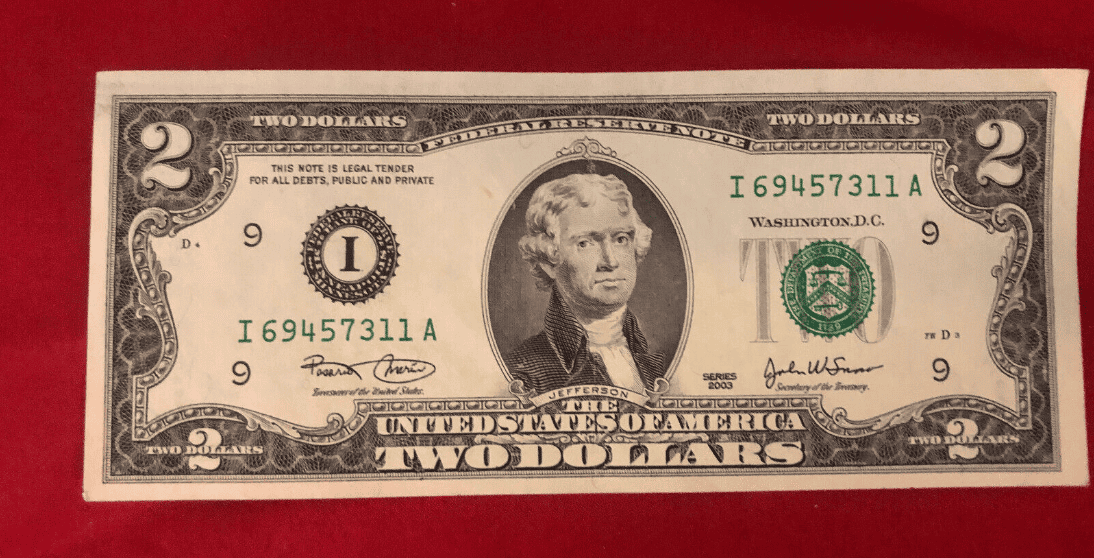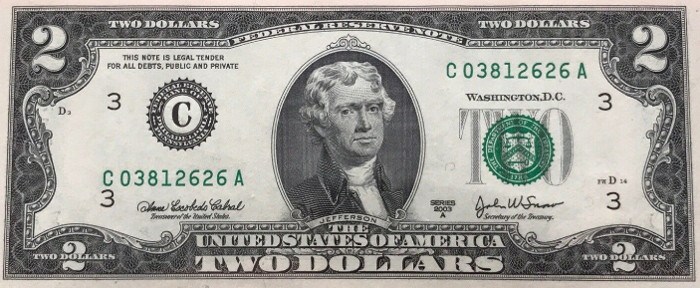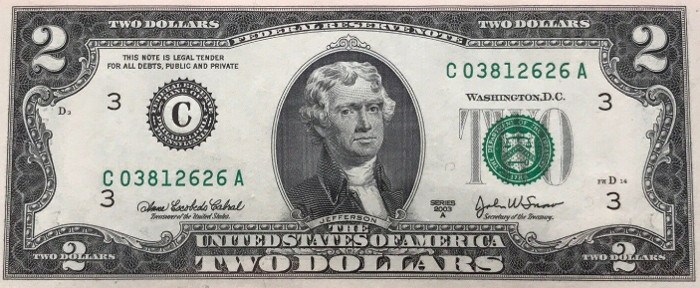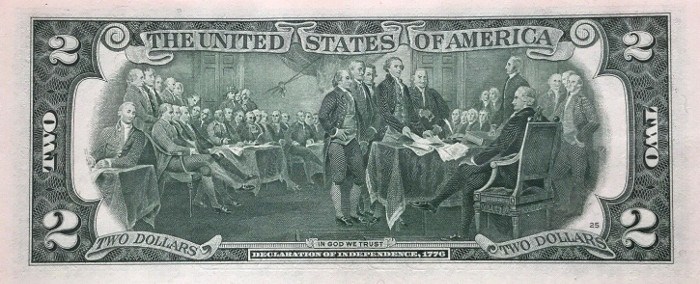2003 $2 Dollar Bill Value: How Much is Series “A” Worth?

A YouTuber did an experiment where he tried to give out $2 Bills. At first, he offered them for free. Later, he attempted to exchange them for $1 Bills. But nobody accepted them. Many had never heard of $2 Bills and assumed they were fake. In reality, while they rarely circulate, the emergency stash of US cash under Mt. Rushmore is allegedly $2B in the form of $2 Bills!
2003 2 Dollar Bill Value Chart |
|||
Bank Note |
Signatories |
Seal Colour |
Price |
| 2003 $2 Bill | Marin and Snow | Green | $2 |
| 2003A $2 Bill | Cabral and Snow | Green | $2 |
| 2003* $2 Bill
12-District Set #1323 |
Marin and Snow | Green | $700 |
History of the 2003 2-Dollar Bill

The $2 Bill has existed in various formats since 1862. It started with Hamilton. In 1869, the front had Thomas Jefferson and the back had lots of versions including Monticello in 1928. After a decade hiatus in 1966, it took on its current style in 1976, with a painting by John Trumbull that was done around 1818. Notes were released on April 13th, Jefferson’s birthday.
You can walk into most bank branches and ask for $2 Bills. They’re still being printed today. The three most recent series of $2 Bills are 2003, 2009, and 2017. This is because new notes are only introduced when the Treasury Secretary or US Treasurer changes, requiring fresh signatories. This means 2003 $2 Bills were printed from 2003 until 2009 in three styles.
We’ll discuss their specific variations in the Value Guides section, but for now, we’ll note they came in three varieties – the 2003, the 2003A, and the 2003* Serial Number #1323. Like all Federal Reserve Bank Notes printed after 1969, they have the light green Treasury Seal with wording in English. Before then, the seal was a darker green (or red) with Latin descriptors.
Modern $2 Bill Specs
Currently, the $2 Bill is 155.95mm long, 66.29mm wide, and weighs about a gram. It uses raised printing with security fibers and is made of 75% cotton and 25% linen. And practically speaking, it’s a profitable note. In 2020, it took about 6 cents to print both $1 and $2 Bills. In 2023, that’s down by half to 2.8 cents, thanks to advanced printing technology and materials.
For reference, the difference between production cost and face value is called seignorage, and it’s a rich source of government revenue. But people don’t use $2 Bills much, so they mostly sit in bank vaults with all the $1 coins. This means the BEP (Bureau of Engraving and Printing) keeps their numbers deliberately low. And that can leave a gap for counterfeiters.
Economic Impact of the $2 Bill
Notably, you may hear of special edition $2 Bills to match America the Beautiful Quarters. These aren’t government-issued. They’re just regular bills embellished with digital graphics and added color. But in the War Years, the military was often paid in $2. Similarly, Geneva Steel paid bonuses in $2 in 1989. Such cases showed the group’s importance to the economy.
$2 Bills are sometimes called Toms (for Thomas Jefferson). And in the past, they had a bad reputation because they were commonly used for vices like gambling, horseracing, political bribes, strip clubs, and brothels. But in modern times, $2 ambassadors try to promote their use in tipping service workers, attending out-of-town sports, and local vacation expenses.
Features of the 2003 2 Dollar Bill
The technical terms used to describe paper money are the same as coin jargon. The obverse is the heads side, the reverse is the tails side, images are devices, the background is the field, and words are legends or mottos. But instead of dies, paper money is printed via a front plate for the obverse and a back plate for the reverse. Impression cylinders transfer the note designs.
Also, let’s touch on some of the symbols, letters, and numbers on a $2 Bill. The circled letter that also starts the serial number is the branch or district. A letter after the date means new signatories. If the serial number ends with a star instead of a letter, it’s a replacement for a damaged note. Tiny letter-number combinations at the inner corners show plate position.
The Obverse of the 2003 2 Dollar Bill

It shows Thomas Jefferson, the 3rd US President. He has more hair (or a larger wig) in this depiction, and his name is under his portrait, followed by The United States of America and Two Dollars. The top of the $2 Bill says Federal Reserve Note and the denomination appears on the top and bottom margins. The signatories, seals, and serial numbers flank the device.
The Reverse of the 2003 2 Dollar Bill

It shows a painting of The Declaration of Independence by John Trumbull. The bottom says Declaration of Independence, 1776, with In God We Trust above that. These are flanked by the denomination, Two Dollars, in words and numbers. They’re also on the side margins. The top says The United States of America. The back plate number is on the lower right.
Other Features of the 2003 2 Dollar Bill
In 2003, all $2 Bills had the green seal which marked them as Federal Reserve Notes. Cash from other years had a range of seal colors including red, brown, maroon, blue, and yellow. Other details on the note include a round seal on the left for the Federal Reserve Branch plus a corresponding letter from A to H. A tiny FW on the lower right means it’s from Fort Worth.
This branch aka district number appears four times. Other numbers include the front plate number, the printing plate position (upper left and lower right), the series number (left of the Secretary’s signature), front plate number (above the lower right district number), and the serial number (lower left and upper right). They all appear on the obverse of the note.
2003 2 Dollar Bill Value Guides
While US coins are minted at the active branches of the US Mint, Dollar Bills are printed at Fort Worth and Washington DC for the 12 Districts of the Federal Reserve Bank, represented by A to H and 1 to 12. Since the 1995 Series, they’re all Fort Worths. And while coins typically show the year they were minted, the date on paper money is when that design was approved.
That means the same series date might be used continually for multiple years. Sometimes the date is followed by a letter e.g. 2003A. This means the design has a slight variation e.g. new signatories. Notes are signed by the Treasury Secretary and the Register and/or the US Treasurer, so whenever someone is appointed, fresh notes are issued with their signature.
2003 $2 Bill Value
The 2003 Series of $2 Bills was signed by US Treasurer Rosario Marin and Secretary of the Treasury John W. Snow. With some practice, you can gather tons of information at a glance. For example, Fr. 1937-A* 2003 $2 is a replacement note printed in Boston. This one had a binary radar rotator serial number, A00011000*. It was graded 65 EPQ Gem Uncirculated.
The $2 Bill sold for $1,440 on August 25th, 2023. The district does make a difference though. During that same August 25th sale, a 1937-K* 2003 Dallas $2 was $1,020 in Choice AU 58. A 1937-D* 2003 $2 from Cleveland was $840 in Choice Uncirculated 64. And a 1937-F* 2003 $2 Bill from Atlanta was $576. The price range is caused by varied interest in the districts.
No-Star 2003 $2 Bill Value
What about regular 2003 $2 Bills without stars? Those aren’t worth very much. On March 9th, 2023, a hundred notes graded AU to Gem only sold for $312. That’s barely $3 each. At the other extreme, the first-ever star $2 i.e. a 1937-E* Richmond 2003 $2 E00000001* sold on 5th April 2022 for a whopping $20,400. The note was graded Gem Uncirculated 65 EPQ.
If you’d like to sell a 2003 $2 without stars at a good price, it needs to have a remarkably fancy serial number and a rather high grade. On August 25th, 2023, a 1938-F 2003 Atlanta $2 sold for $7,200. It was graded Gem Uncirculated 67 EPQ and its serial number was Solid 1s i.e. #F11111111A. The crucial lesson here is to carefully check the serial number on your $2!
2003* $2 Bill Serial Number #1323 Value
The prices we’ve mentioned above were star notes. But the BEP (Bureau of Printing and Engraving) printed a special set of 12 Premium Federal Reserve Notes. The set had one note for every branch of the Federal Reserve Bank, all with #1323* as their serial number such as the B00001323* for the New York City District or the J00001323 for Kansas City, Missouri.
Their issuing price was $495 and the BEP only made with 2,000 sets. They were in such high demand that they sold out in five days. They were packed in clear plastic sleeves and bound in an album with a district write-up and authenticating certificate. Today, complete sets of these replacement notes can sell for $700 if they’re graded between 63 Choice to 66 Gem.
You can gather a set of 2003 $2 Bills and sell them as a special batch. Look for fancy serial numbers, pick one from each branch, and get high grades. A set of A to L Star $2 ranging from Choice to Gem was $900 in August 2023. Serial numbers included #8008*, #9009*, and #1707*. But an uncirculated #1347 set was only $288 in 2022 and a #1346 set was $360.
2003A $2 Bill Value
The 2003A Series of $2 Bills was signed by Treasurer Anna Escobedo Cabral and Treasury Secretary John W. Snow. On their own, 2003A $2 Bills aren’t worth much unless you find a fancy serial number. Otherwise, they’re generally mixed into bigger batches and/or mingled with other denominations. On August 25th, 2003, someone sold a set of 46 $1 and $2 Bills.
Their series ranged from 1976 to 2003A and the whole set was $720. That means each $2 Bill was roughly $15.65. They had fancy doubling serial numbers though, like #F00910091A. Also, they’re in upper grades from Choice to Gem. Another mixed set of 78 $2 Bills with 1995 to 2003As sold for $960 the same day. The selling point was high six-figure serial numbers.
Collectors can also buy Uncut Sheets of $2 Bills from BEP. You can buy sheets with four, eight, sixteen, or thirty-two notes a piece. For reference, the letter-number combination that we mentioned earlier describes which part of the sheet your $2 Bill came from e.g. E2 or J5. This appears on the inner top left and the inner bottom right (above the District Number).
2003 2 Dollar Bill Grading
Just like coins, paper money grades are based on the Sheldon Scale. But lots of other features can affect pricing e.g. stars for replacement notes or mint errors that occur during printing. The usual grades go from Poor (1) to Superb Gem Circulated (70). Also, PCGS uses PPQ 65 to 70 for Premium Paper Quality while PMG uses EPQ 65 to 70 for Exceptional Paper Quality.
When you’re looking at the description of a slabbed note from an appraisal company, you might notice a Fr. Number. It’s not part of the grading system. It stands for Friedberg and is an ID tag from the 1953 book Paper Money of the United States by Robert Friedberg. It lists every bank note ever issued so it’s a useful metric. His sons Ira and Arthur keep it up to date.
2003 2 Dollar Bill Errors
US Paper Money is printed in three swipes. First is the reverse, then the obverse, then the colored seals and serial numbers. And mint mistakes can raise the value of a note. These errors include various paper folds, problems with the impression cylinder, issues with paper cutting, broken boards, smears and smudges, etc. Let’s look at some 2003 $2 Bill Errors.
2003 Atlanta $2 Obstructed Face Error
Usually, the printing paper is slid onto a board that keeps it in place. The impression cylinder is then dipped in ink and rolled over the note to make a bill. But sometimes, an object might cover part of the printing paper and end up hiding certain sections of the design. On this $2 Bill, something blocked the margin leaving a white stripe. Graded 67 PPQ, it sold for $310.
2003 Chicago $2 Stuck Digit Error
The Stuck Digit Error is also known as the Gas Pump or Raised Pump Error, referring to the way numbers move on the screen when you’re filling your gas tank. The error appears on the serial number when one of the numbers on the dial slips higher or lower than the rest. In this case, the last 5 on the left is slightly lower, and in the grade of 66 PPQ, this note sold for $120.
2003 2 Dollar Bill FAQ
What is a 2003 $2 Bill Worth?
Most $2 Bills from 2003 are only worth their face value. But if you can find a high-grade note with fancy serial numbers, you can fetch as much as $20,000 with one sale verified in 2022.
